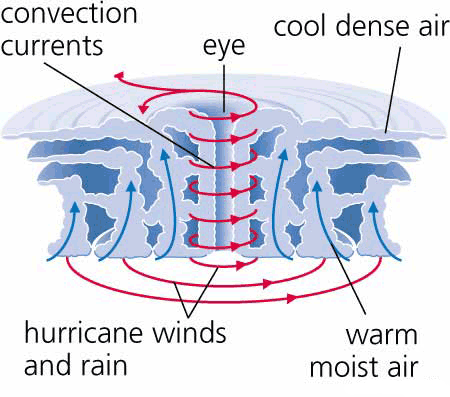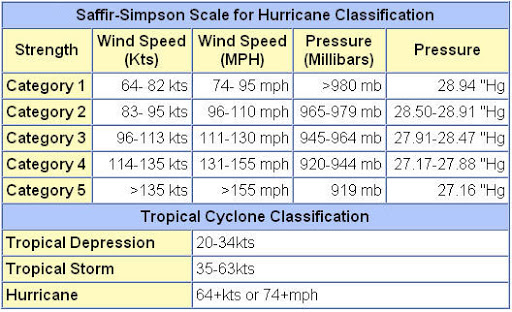HURRICANE
HURRICANE
– Strong Center of Low P
– Sustained winds > 74 mph, To be considered a Category 1 Hurricane
– On average there are 45 hurricanes/yr
– Size ranges from 60 miles-900 miles, with a typical size of about 400 miles
– Can last from days to weeks
What do they need to form?
– Consistent heating of the surface
– High Humidities
– Cumulus & Cumulonimbus Clouds
Formation Regions Hurricanes are called by other names (depending on where they occur)
1. Hurricanesin the Atlantic & East Pacific
2. Cyclonesin Indian Ocean near Australia
3. Typhoons off coast of China & Indonesia
Tropical Cyclone Life Cycle
1. Tropical Depression surface wind<39mph
2. Tropical Storm 39≤surface wind≤ 74mph
3. Hurricane surface winds > 74 mph
Tropical Disturbance
The majority of tropical storms & hurricanes start out as tropical disturbances
unorganized masses of thunderstorms with very little organized wind circulation
During the hurricane season in the Atlantic Ocean & Gulf of Mexico, tropical disturbances often grow from a pattern of stormy weather, called an African easterly wave
These waves typically emerge every 3-4 days off the W coast of Africa & then drift W within the trade winds into the Atlantic Ocean
If weather & ocean conditions continue to be favorable, the system may then strengthen
Tropical Depression
As a system continues to become organized & winds begin to circulate, it become tropical depression, weakest form of tropical cyclone
It is called a “depression” because it has low, or depressed, air p at its center
As the system develops, winds converge towards the center P near the center drops
During this transition, the disturbance begins to obtain its energy from the ocean not from horizontal T gradients in atm & env.wind
Tropical Storm
As bands of thunderstorms continue to develop, the depression may intensify into a tropical storm with max sustained wind speeds of 63‐117.5 km/hr
A tropical storm usually forms in this manner (from intensifying tropical depression)
Once a system is classified as a tropical storm, it is given a name
Approx. 100 tropical cyclones / yr
Many of tropical cyclones die out before they can grow stronger, with only approximately half of them (50) eventually strengthening into a mature hurricane (or typhoon)
Hurricanes
If a tropical cyclone obtains a maximum sustained wind speed > 119 km/hr, it classified as a hurricane (Typhoon or Cyclone)
At this point, the recognizable, cloud‐free eye of a hurricane typically forms
In the Atlantic, Central oe E-Pacific, hurricane intensity classified based on max surface wind speed using the 5 categories of the Saffir‐Simpson Hurricane Wind Scale
Ingredients for Hurricane Formation
Warm ocean T > 27°C, deep 200m
– need lots of evaporation
– winds churn up water → WARM water
– Both only happen equatorward of 20°N-S
Coriolis
– needed to initiate the spinning
– Need to be between > 5°N-S
Low values of vertical wind sheer
– Necessary for the storm to organize
Hurricane Structure
As air rushes inward in spiral pattern bands of clouds & thunderstorms are formed
Closer to the “eye” you get:
– The most severe thunderstorms
– The most intense rain & wind
– The eye wall has the highest wind & rain
There can be more than three sets of bands

Hurricane Intensification
The storm can intensify if there is:
Weak vertical sheer: allows condensation energy to be concentrated over a small area
Moist humid air in the upper troposphere: lots of condensation
Cold upper atm conditions: leads to a large PGF
Hurricane Damage
Wind Damages
– Hurricanes move at 45 mi/hr
– converging air moves at a faster velocity
– The velocity of the winds you experience depends on your location within hurricane
ν.motion + ν.rotation (100 + 45) m/h = 145
ν.motion – ν.rotation (100 – 45) m/h = 65
Storm Surges
– abnormal rise of sea along shore
– result of strong winds
– Can be as high as 7 m, Typically 1-2 m
– waves around 6-15 m can occur
Flooding
– Caused by intense rains that accumulate
– Rain accumulation can be up to 10 ft/day
– Typical numbers are 1-3 ft/day

Hurricane Decay
When conditions become unfavorable the hurricane starts to decay
Colder sea surface T: < 80F will cause the storm to weaken or even dissipate
Land friction caused by large land mass, & their terrain cuts off the hurricane’s circulation, & squeezes out storm’s moisture
Shearing winds aloft
– Tropical storms & hurricanes are vertically stacked systems
– Hostile upper level wind conditions produce shearing, which blow off the high cloud tops of these storms, & causes them to become disorganized
Sinking air: subsidence from high P such as subtropical ridge can inhibit development.
– Sinking air from high P hinders thunderstorm development, which is a critical element in hurricane strengthening
In general
Hurricane Watch
– if poses a direct threat to an area
– Issued 24‐48 hr before storm arrives
– Issued by the National Hurricane Center
Hurricane Warning
– if it appears that storm will strike an area
– The warning is accompanied by a percent chance of the hurricane center passing with in 65mi of a particular community
– Typically within 36 hours
Hurricane Impact
Flooding
Storm Surge
Wind Damage
Energy of winds = wind V squared: E = V²
A doubling of the wind speed
results in 4 timesthe destructive energy
Naming Hurricanes
If reach tropical storm strength (40‐74 mph)
Used to be all women’s names
Now they alternate male‐female
Names “Retired” if cause enough damage
CENTRAL PACIFIC Has their OWN List that used for Hawaii
HURRICANE GROUP ACTIVITIY
GROUP 1 : Super Typhoon Haiyan
GROUP 2: Hurricane Katrina
GROUP 3: Superstorm Sandy
GROUP 4: Hurricane Patricia
GROUP 5: Hurricane Rita
GROUP 6: Hurricane Andrew
Group 7: Galveston Hurricane
Group 8: Hurricane Floyd
Group 9: Hurricane Camille
Group 10: Hurricane Wilma
The End
